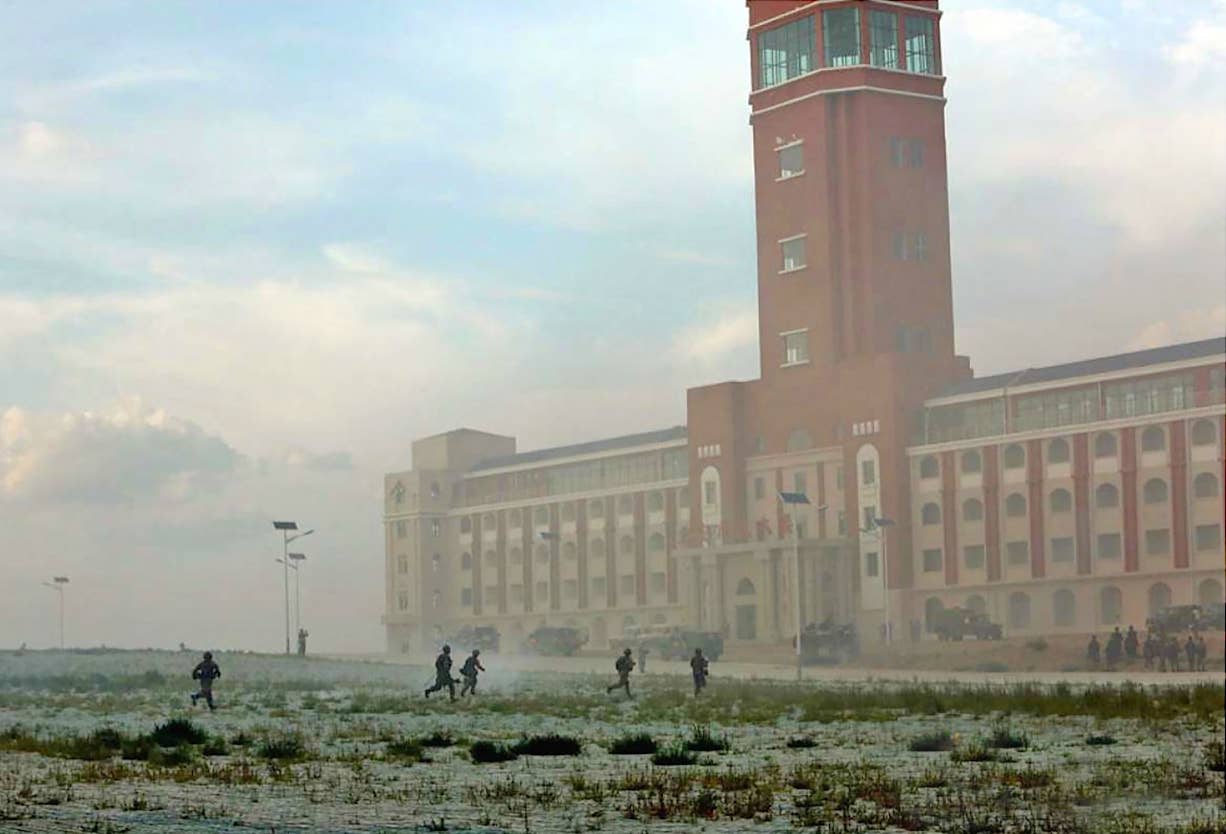A new satellite image has emerged online, unveiling a meticulously detailed replica of Taiwan’s Presidential Office nestled within a military training compound in China’s Inner Mongolia region.
A Taiwanese defense analyst took to social media to share a satellite image depicting a detailed mockup of Taipei’s crucial administrative district, designed explicitly for PLA training.
The satellite images, posted on March 26, reveal a replica of the Bo’ai Special Zone, a restricted area in Taipei’s Zhongzheng District housing significant government buildings, including the Presidential Office Building.
This training ground is in the Alxa Left Banner administrative division of Alxa League in southwest China’s Inner Mongolia. Wen pointed out that while previous mockups have included replicas of specific buildings, such as the Presidential Office Building, this latest iteration encompasses a larger portion of the Bo’ai Special Zone.
He suggested that the mockup appears to serve as an aerial bombing and gunnery training range, indicating a comprehensive approach to simulating combat scenarios.
朱日和的是總統府,但這次內蒙古阿拉善左旗的佈景,準確來說是博愛特區,不過性質似乎不同,阿拉善的比較像炸射靶場。 https://t.co/ESWXMwthKg pic.twitter.com/kymsQJgaRH
— Joseph.W 約瑟 (@JosephWen___) March 26, 2024
Reports indicate that construction of the mock office began in March 2021 and was nearly completed by October of the same year. This development reflects the PLA’s efforts to create highly realistic environments to prepare its forces for potential conflicts.
This is not the first instance of such military preparations by China. In 2015, China Central Television showcased a military exercise at the Zhurihe Training Base in Inner Mongolia, featuring PLA soldiers simulating the storming of a building resembling the Japan-era office of Taiwan’s president.
Satellite images from 2020 also revealed a massive mockup of downtown Taipei at the same training base, complete with replicas of key governmental buildings.
The backdrop to these developments is the ongoing tension between China and Taiwan. The Chinese Communist Party considers Taiwan a part of its territory and has not ruled out the use of force to assert control over the island.
The latest disclosure comes amid heightened concerns regarding China’s military modernization. Admiral John Aquilino, commander of the U.S. Indo-Pacific Command, warned of a PLA invasion of Taiwan by 2027 during a testimony to the US Armed Services Committee on March 20.
The emergence of the PLA’s mockup of Taipei for military training also serves as a stark reminder of the persistent geopolitical tensions in the region and the ever-looming specter of conflict between China and Taiwan.
Defense Experts Weigh In On PLA’s Mockup Of Taipei For Military Training
The revelation of the People’s Liberation Army’s (PLA) mockup of Taipei for military training has brought renewed attention to the symbolic significance of Taiwan’s Presidential Office Building.
The Presidential Office Building in Taiwan isn’t only a place for governance — it is a symbol of the island’s history and its struggle for independence. Built during Japan’s rule from 1912 to 1919, it survived World War II’s destruction and was restored during Taiwan’s Nationalist era from 1947 to 1948. Back then, it was called Chieh Shou Hall, honoring Chiang Kai-shek’s leadership.
This building represents Taiwan’s journey, standing strong despite pressures from mainland China. Its resilience reflects Taiwan’s determination to chart its path. But the replica of this building in Zhurihe hints at China’s desire to reclaim Taiwan and is a reminder of the ongoing tension between independence and outside influence.
In response to the recent revelation of the People’s Liberation Army (PLA) of China’s mockup of Taipei for military training, Taiwanese defense officials and experts have offered their insights and reactions, shedding light on the implications of this development.
Lu Te-yun, a satellite imagery expert and former inspector for the Ministry of National Defense (MND), informed Taiwan-based United Daily News that the mockup exhibits a remarkable level of realism. He emphasized that although precise measurements are necessary for an accurate assessment of proportions visually, it closely resembles the actual location.

His comments underscore the meticulousness with which the PLA has crafted the training grounds, indicative of their commitment to preparedness for potential scenarios involving Taipei.
When asked to comment on the mockup, Defense Minister Chiu Kuo-cheng emphasized that replication of facilities by any country is not uncommon. He acknowledged that Taiwan’s military also conducts simulations and exercises, echoing the sentiment that such preparations are standard practice in modern warfare.
Former Kuomintang (KMT) Legislator Lin Yu-fang also offered a perspective on the PLA’s potential to launch a decapitation strike on Taipei and suggested that considering Taiwan’s extensive air defenses, the swift execution of a decapitation strike on Taipei by the PLA appears unlikely.
Lin characterized the situation as psychological and cognitive warfare, with China employing a dual strategy of negotiation and confrontation.
Su Tzu-Yun, a security analyst at the Institute for National Defense and Security Research, a Taiwanese think tank, highlighted in an interview with Taiwan Plus News that China has been steadily intensifying its realistic and combat-focused training efforts in recent years to enhance its armed forces.
Additionally, China has implemented more systematic countermeasures. Nonetheless, these mockups also provide Taiwan with insight into how China may plan to stage its invasion.
- Contact the author at ashishmichel(at)gmail.com
- Follow EurAsian Times on Google News




